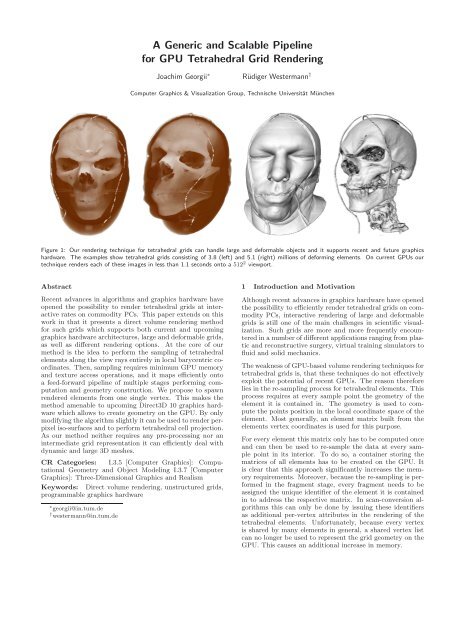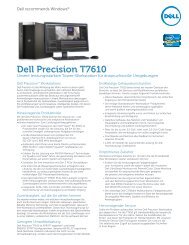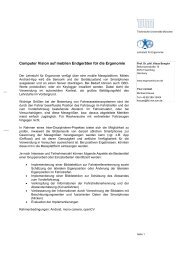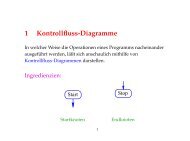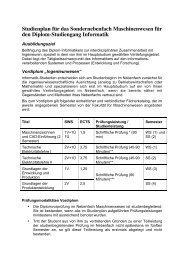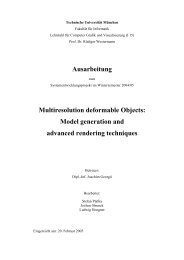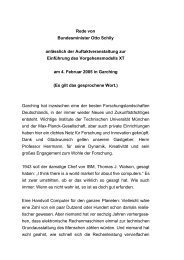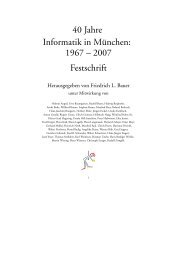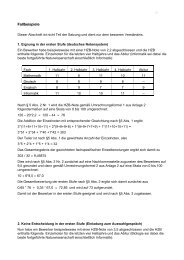A Generic and Scalable Pipeline for GPU Tetrahedral Grid ... - TUM
A Generic and Scalable Pipeline for GPU Tetrahedral Grid ... - TUM
A Generic and Scalable Pipeline for GPU Tetrahedral Grid ... - TUM
You also want an ePaper? Increase the reach of your titles
YUMPU automatically turns print PDFs into web optimized ePapers that Google loves.
A <strong>Generic</strong> <strong>and</strong> <strong>Scalable</strong> <strong>Pipeline</strong><br />
<strong>for</strong> <strong>GPU</strong> <strong>Tetrahedral</strong> <strong>Grid</strong> Rendering<br />
Joachim Georgii ∗ Rüdiger Westermann †<br />
Computer Graphics & Visualization Group, Technische Universität München<br />
Figure 1: Our rendering technique <strong>for</strong> tetrahedral grids can h<strong>and</strong>le large <strong>and</strong> de<strong>for</strong>mable objects <strong>and</strong> it supports recent <strong>and</strong> future graphics<br />
hardware. The examples show tetrahedral grids consisting of 3.8 (left) <strong>and</strong> 5.1 (right) millions of de<strong>for</strong>ming elements. On current <strong>GPU</strong>s our<br />
technique renders each of these images in less than 1.1 seconds onto a 512 2 viewport.<br />
Abstract<br />
Recent advances in algorithms <strong>and</strong> graphics hardware have<br />
opened the possibility to render tetrahedral grids at interactive<br />
rates on commodity PCs. This paper extends on this<br />
work in that it presents a direct volume rendering method<br />
<strong>for</strong> such grids which supports both current <strong>and</strong> upcoming<br />
graphics hardware architectures, large <strong>and</strong> de<strong>for</strong>mable grids,<br />
as well as different rendering options. At the core of our<br />
method is the idea to per<strong>for</strong>m the sampling of tetrahedral<br />
elements along the view rays entirely in local barycentric coordinates.<br />
Then, sampling requires minimum <strong>GPU</strong> memory<br />
<strong>and</strong> texture access operations, <strong>and</strong> it maps efficiently onto<br />
a feed-<strong>for</strong>ward pipeline of multiple stages per<strong>for</strong>ming computation<br />
<strong>and</strong> geometry construction. We propose to spawn<br />
rendered elements from one single vertex. This makes the<br />
method amenable to upcoming Direct3D 10 graphics hardware<br />
which allows to create geometry on the <strong>GPU</strong>. By only<br />
modifying the algorithm slightly it can be used to render perpixel<br />
iso-surfaces <strong>and</strong> to per<strong>for</strong>m tetrahedral cell projection.<br />
As our method neither requires any pre-processing nor an<br />
intermediate grid representation it can efficiently deal with<br />
dynamic <strong>and</strong> large 3D meshes.<br />
CR Categories: I.3.5 [Computer Graphics]: Computational<br />
Geometry <strong>and</strong> Object Modeling I.3.7 [Computer<br />
Graphics]: Three-Dimensional Graphics <strong>and</strong> Realism<br />
Keywords: Direct volume rendering, unstructured grids,<br />
programmable graphics hardware<br />
∗ georgii@in.tum.de<br />
† westermann@in.tum.de<br />
1 Introduction <strong>and</strong> Motivation<br />
Although recent advances in graphics hardware have opened<br />
the possibility to efficiently render tetrahedral grids on commodity<br />
PCs, interactive rendering of large <strong>and</strong> de<strong>for</strong>mable<br />
grids is still one of the main challenges in scientific visualization.<br />
Such grids are more <strong>and</strong> more frequently encountered<br />
in a number of different applications ranging from plastic<br />
<strong>and</strong> reconstructive surgery, virtual training simulators to<br />
fluid <strong>and</strong> solid mechanics.<br />
The weakness of <strong>GPU</strong>-based volume rendering techniques <strong>for</strong><br />
tetrahedral grids is, that these techniques do not effectively<br />
exploit the potential of recent <strong>GPU</strong>s. The reason there<strong>for</strong>e<br />
lies in the re-sampling process <strong>for</strong> tetrahedral elements. This<br />
process requires at every sample point the geometry of the<br />
element it is contained in. The geometry is used to compute<br />
the points position in the local coordinate space of the<br />
element. Most generally, an element matrix built from the<br />
elements vertex coordinates is used <strong>for</strong> this purpose.<br />
For every element this matrix only has to be computed once<br />
<strong>and</strong> can then be used to re-sample the data at every sample<br />
point in its interior. To do so, a container storing the<br />
matrices of all elements has to be created on the <strong>GPU</strong>. It<br />
is clear that this approach significantly increases the memory<br />
requirements. Moreover, because the re-sampling is per<strong>for</strong>med<br />
in the fragment stage, every fragment needs to be<br />
assigned the unique identifier of the element it is contained<br />
in to address the respective matrix. In scan-conversion algorithms<br />
this can only be done by issuing these identifiers<br />
as additional per-vertex attributes in the rendering of the<br />
tetrahedral elements. Un<strong>for</strong>tunately, because every vertex<br />
is shared by many elements in general, a shared vertex list<br />
can no longer be used to represent the grid geometry on the<br />
<strong>GPU</strong>. This causes an additional increase in memory.
To avoid the memory overhead induced by precomputations,<br />
element matrices can be calculated in<br />
turn <strong>for</strong> every sample point. But then the same computations,<br />
including multiple memory access operations to<br />
fetch the respective coordinates, have to be per<strong>for</strong>med<br />
<strong>for</strong> all sample points in the interior of a single element,<br />
thereby wasting a significant portion of the <strong>GPU</strong>s compute<br />
power. As be<strong>for</strong>e, identifiers are required to access vertex<br />
coordinates, <strong>and</strong> thus a shared vertex array cannot be used.<br />
1.1 Contribution<br />
In this paper we present a <strong>GPU</strong> pipeline <strong>for</strong> the rendering of<br />
tetrahedral grids that avoids the a<strong>for</strong>ementioned drawbacks.<br />
This pipeline is scalable with respect to both large data sets<br />
as well as future graphics hardware. The proposed method<br />
has the following properties:<br />
• Per-element calculations are per<strong>for</strong>med only once.<br />
• <strong>Tetrahedral</strong> vertices <strong>and</strong> attributes can be shared in<br />
vertex <strong>and</strong> attribute arrays.<br />
• Besides the shared vertex <strong>and</strong> attribute arrays no additional<br />
memory is required on the <strong>GPU</strong>.<br />
• Re-sampling of (de<strong>for</strong>ming) tetrahedral elements is per<strong>for</strong>med<br />
using a minimal memory footprint.<br />
1.2 System Overview<br />
To achieve our goal we propose a generic <strong>and</strong> scalable <strong>GPU</strong><br />
rendering pipeline <strong>for</strong> tetrahedral elements. This pipeline is<br />
illustrated in Figure 2. It consists of multiple stages per<strong>for</strong>ming<br />
element assembly, primitive construction, rasterization<br />
<strong>and</strong> per-fragment operations.<br />
Figure 2: Overview of the <strong>GPU</strong> rendering pipeline.<br />
To render a tetrahedral element the pipeline is fed with one<br />
single vertex, which carries all in<strong>for</strong>mation necessary to assemble<br />
the element geometry on the <strong>GPU</strong>. This stage is described<br />
in Section 3.1. Assembled geometry is then passed<br />
to the construction stage where a renderable representation<br />
is built.<br />
The construction stage is explicitly designed to account <strong>for</strong><br />
the functionality on upcoming graphics hardware. With Direct3D<br />
10 compliant hardware <strong>and</strong> geometry shaders [1] it<br />
will be possible to create additional geometry on the graphics<br />
subsystem. In particular, triangle strips or fans composed<br />
of several vertices, each of which can be assigned individual<br />
per-vertex attributes, can be spawned from one single<br />
vertex. As the geometry shader itself can per<strong>for</strong>m arithmetic<br />
<strong>and</strong> texture access operations, these attributes can be<br />
computed in account of the application specific needs. By<br />
using the a<strong>for</strong>ementioned functionality the renderable representation<br />
can be constructed in turn without sacrificing<br />
the feed-<strong>for</strong>ward nature of the proposed rendering pipeline.<br />
Section 3.2 gives in-depth details on this stage.<br />
As hardware-assisted geometry shaders are not yet available<br />
on current <strong>GPU</strong>s we have implemented the proposed<br />
pipeline using the DirectX9 SDK. This SDK provides a software<br />
emulation of the entire Direct3D 10 pipeline, <strong>and</strong> it is<br />
available under the recent Microsoft Vista beta version. Un<strong>for</strong>tunately,<br />
neither does this emulation provide meaningful<br />
per<strong>for</strong>mance measures nor does it allow to estimate relative<br />
timings between the pipeline stages. Nevertheless, the implementation<br />
using this software emulation clearly demonstrates<br />
that the proposed pipeline concept can effectively be<br />
mapped onto upcoming <strong>GPU</strong>s in the very near future.<br />
To verify the efficiency of the intended method we propose<br />
an emulation of the primitive construction step using the<br />
render-to-vertexbuffer functionality. The specific implementation<br />
will be discussed in Section 6. Although this emulation<br />
requires additional rendering passes it still results in<br />
frame rates superior to those that can be achieved by the<br />
fastest methods known so far.<br />
The renderable representation is then sent to the <strong>GPU</strong> rasterizer.<br />
On the fragment level a number of different rendering<br />
techniques can be per<strong>for</strong>med <strong>for</strong> each tetrahedron,<br />
including a ray-based approach, iso-surface rendering <strong>and</strong><br />
cell projection. The discussion in the remainder of this paper<br />
will be focused on the first approach, <strong>and</strong> we will briefly<br />
describe the other rendering variants in Sections 4 <strong>and</strong> 5.<br />
The ray-based approach operates similar to ray-casting by<br />
sampling the data along the view rays. In contrast, however,<br />
it does not compute <strong>for</strong> each ray the set of elements consecutively<br />
hit along that ray, but it lets the rasterizer compute<br />
<strong>for</strong> each element the set of rays intersecting that element.<br />
The interpolation of the scalar field at the sample points in<br />
the interior of each element is then per<strong>for</strong>med in the fragment<br />
stage, <strong>and</strong> the results are finally blended into the color<br />
buffer.<br />
The approach as described requires the tetrahedral elements<br />
to be sampled in correct visibility order. To avoid the explicit<br />
computation of this ordering we first partition the eye<br />
coordinate space into spherical shells around the point of<br />
view. Figure 3 illustrates this partitioning strategy.<br />
Figure 3: Ray-based tetrahedra sampling.<br />
These shells are consecutively processed in front-to-back order,<br />
simultaneously keeping the list of elements overlapping<br />
the current shell. Intra-shell visibility ordering is then<br />
achieved by re-sampling the elements onto spherical slices<br />
positioned at equidistant intervals in each shell (see right<br />
of Figure 3). In Section 3.3 we will show how to efficiently<br />
per<strong>for</strong>m the re-sampling using multiple render targets.<br />
To minimize the number of arithmetic <strong>and</strong> memory access<br />
operations the re-sampling procedure is entirely per<strong>for</strong>med<br />
in barycentric coordinate space of each element. This ap-
proach has some important properties: First, barycentric<br />
coordinates of sample points can directly be used to interpolate<br />
the scalar values given at grid vertices. Second,<br />
barycentric coordinates can efficiently be used to determine<br />
whether a point lies inside or outside an element. Third, by<br />
trans<strong>for</strong>ming both the point of view <strong>and</strong> the view rays into<br />
the barycentric coordinate space of an element, barycentric<br />
coordinates of sample points along the rays can be computed<br />
with a minimum number of arithmetic operations. Fourth,<br />
barycentric coordinates of vertices as well as barycentric coordinates<br />
of the view rays through the vertices can be issued<br />
as per-vertex attributes, which then get interpolated across<br />
the element faces during rasterization.<br />
1.3 Related Work<br />
Object-space rendering techniques <strong>for</strong> tetrahedral grids accomplish<br />
the rendering by projecting each element onto the<br />
view plane to approximate the visual stimulus of viewing the<br />
element. Two principal methods have been shown to be very<br />
effective in per<strong>for</strong>ming this task: slicing <strong>and</strong> cell projection.<br />
Slicing approaches can be distinguished in the way the computation<br />
of the sectional polygons is per<strong>for</strong>med. This can<br />
either be done explicitly on the CPU [29, 33], or implicitly<br />
on a per-pixel basis by taking advantage of dedicated<br />
graphics hardware providing efficient vertex <strong>and</strong> fragment<br />
computations [22, 26, 28].<br />
<strong>Tetrahedral</strong> cell projection [17], on the other h<strong>and</strong>, relies<br />
on explicitly computing the projection of each element onto<br />
the view plane. Different extensions to the cell-projection<br />
algorithm have been proposed in order to achieve better accuracy<br />
[21, 31] <strong>and</strong> to enable post-shading using arbitrary<br />
transfer functions [16]. <strong>GPU</strong>-based approaches <strong>for</strong> cell projection<br />
have been suggested, too [23, 25, 32].<br />
The most difficult problem in tetrahedral cell projection is<br />
to determine the correct visibility order of elements. The<br />
most efficient way is PowerSort [3, 8], which exploits the<br />
fact that <strong>for</strong> tetrahedral meshes exhibiting a Delaunay property<br />
the correct order can be found by sorting the tangential<br />
distances to circumscribing spheres using any customized algorithm.<br />
As grids in practical applications are usually not<br />
Delaunay meshes this approach might lead to incorrect results<br />
<strong>and</strong> does not allow resolving topological cycles in the<br />
data.<br />
A different alternative is the sweep-plane approach [7, 18, 19,<br />
27]. In this approach the coherence within cutting planes in<br />
object space is exploited in order to determine the visibility<br />
ordering of the available primitives. In addition, much<br />
work has been spent on accelerating the visibility ordering<br />
of unstructured elements. The MPVO method [30], <strong>and</strong><br />
later extended variants of it [4, 20], were designed to take<br />
into account topological in<strong>for</strong>mation <strong>for</strong> visibility ordering.<br />
Techniques using convexification to make concave meshes<br />
amenable to MPVO sorting have been proposed in [15]. Recently<br />
a method to overcome the topological sorting of unstructured<br />
grids has been presented [2]. By using an initial<br />
sorter on the CPU a small set of <strong>GPU</strong>-buffers can be used<br />
to determine the visibility order on a per-fragment basis.<br />
Based on the early work on <strong>GPU</strong> ray-casting [13] a raybased<br />
approach <strong>for</strong> the rendering of tetrahedral grids has<br />
been proposed in [24].<br />
Besides the direct volume rendering of tetrahedral grids<br />
there has also been an ongoing ef<strong>for</strong>t to employ <strong>GPU</strong>s <strong>for</strong><br />
iso-surface extraction in such grids [5]. The calculation of<br />
the iso-surface inside the tetrahedral elements was carried<br />
out in the vertex units of programmable graphics hardware<br />
[12, 14]. Significant accelerations were later achieved by employing<br />
parallel computations <strong>and</strong> memory access operations<br />
in the fragment units of recent <strong>GPU</strong>s in combination with<br />
new functionality to render constructed geometry without<br />
any read-back to the CPU [9, 10].<br />
2 Data Representation <strong>and</strong> Transfer<br />
The tetrahedral grid is maintained in the most compact representation:<br />
a shared vertex array that contains all vertex coordinates<br />
<strong>and</strong> an index array consisting of one 4-component<br />
entry per element. Each component represents an index into<br />
the vertex array. While the index array only resides in CPU<br />
memory, the vertex array is stored on the CPU, <strong>and</strong> as a 2D<br />
floating point texture on the <strong>GPU</strong>. Additional per-vertex<br />
attributes like scalar or color values are only hold on the<br />
<strong>GPU</strong>.<br />
By assigning to each vertex a 3D texture coordinate it is also<br />
possible to bind a 3D texture map to the tetrahedral grid.<br />
By one additional texture indirection the scalar or color values<br />
can then be sampled via interpolated texture coordinates<br />
from a 3D texture map. This strategy is in particular useful<br />
<strong>for</strong> the efficient rendering of de<strong>for</strong>ming Cartesian grids.<br />
By de<strong>for</strong>ming the geometry of a tetrahedral grid but keeping<br />
the 3D texture coordinates fix, the de<strong>for</strong>med object can<br />
be rendered at much higher resolution compared to just linear<br />
interpolation of the scalar field given at the displaced<br />
tetrahedra vertices.<br />
To render a tetrahedral grid the CPU computes <strong>for</strong> each<br />
spherical shell the set of elements (active elements) overlapping<br />
this shell. Each time a shell is to be rendered the<br />
CPU uploads this active element list, represented as a 4component<br />
index array. This list is then passed through the<br />
proposed rendering pipeline.<br />
3 <strong>Tetrahedral</strong> <strong>Grid</strong> Rendering<br />
In this section we describe the rendering pipeline <strong>for</strong> tetrahedral<br />
grids, which is essentially a sampling of the attribute<br />
field at discrete points along the view rays through the grid.<br />
The sampling process effectively comes down to determining<br />
<strong>for</strong> each sampling point the tetrahedron that contains<br />
this point as well as the points position in local barycentric<br />
coordinates of this tetrahedron. Due to this observation we<br />
decided to rigorously per<strong>for</strong>m the rendering of each element<br />
in local barycentric space, thus minimizing the number of<br />
required element <strong>and</strong> fragment operations. Figure 4 shows<br />
a conceptual overview of the entire rendering pipeline <strong>for</strong><br />
tetrahedral grids. For the sake of clarity, pseudo-code notation<br />
is given in Appendix A.<br />
3.1 Element Assembly<br />
For every shell to be rendered the active element list contains<br />
one vertex per element, each of which stores four references<br />
into the vertex texture. In the element assembly stage these
Figure 4: Data stream overview<br />
indices are resolved by interpreting them as texture coordinates.<br />
Via four texture access operations the four vertices<br />
are obtained, <strong>and</strong> they are then trans<strong>for</strong>med into eye coordinate<br />
space. Both the four indices as well as the trans<strong>for</strong>med<br />
vertices are passed to the primitive construction stage.<br />
3.2 Primitive Construction<br />
The primitive construction stage generates all the in<strong>for</strong>mation<br />
that is used in the upcoming stages but only needs to be<br />
computed once per element. First, <strong>for</strong> every element the matrix<br />
required to trans<strong>for</strong>m eye coordinates into local barycentric<br />
coordinates is computed. The vertices, given in homogeneous<br />
eye coordinates, are denoted by vi, i ∈ {0, 1, 2,3}.<br />
The trans<strong>for</strong>mation matrix can then be computed as<br />
B = � v0 v1 v2 v3<br />
� −1 .<br />
Next, <strong>for</strong> every element the eye position veye = (0,0, 0,1) T<br />
is trans<strong>for</strong>med into its barycentric coordinate space: beye =<br />
B veye. It is important to note that only the last column<br />
of B is required thus significantly reducing the number of<br />
arithmetic operations to be per<strong>for</strong>med. The barycentric coordinates<br />
of each of the vertices vi are given by the canonical<br />
unit vectors ei. Finally, the directions of all four view rays<br />
passing through the element vertices are trans<strong>for</strong>med into<br />
barycentric coordinates via bi = ei − beye. As the mapping<br />
from eye coordinate space to barycentric coordinate space is<br />
affine, these directions can later be interpolated across the<br />
element faces. In addition, the length of the view vector,<br />
li = ||vi − veye||2, is computed <strong>for</strong> every vertex in the primitive<br />
construction stage. It is used in the fragment stage to<br />
normalize the barycentric ray directions bi.<br />
Once the a<strong>for</strong>ementioned per-element computations have<br />
been per<strong>for</strong>med, each tetrahedron is rendered as a triangle<br />
strip consisting of four triangles. These strips are composed<br />
of the six element vertices, which are first trans<strong>for</strong>med to<br />
normalized device coordinates. To each of these vertices<br />
the respective bi, the barycentric eye position beye <strong>and</strong> the<br />
length of the view vector li are assigned as additional pervertex<br />
attributes, i.e. texture coordinates. Moreover, four<br />
per-element indices into the <strong>GPU</strong> attribute array are assigned<br />
to each vertex. These indices are later used in the<br />
fragment stage to access the scalar field or the 3D texture<br />
coordinates used to bind a texture map.<br />
The rasterizer generates one fragment <strong>for</strong> every view ray<br />
passing through a tetrahedron, <strong>and</strong> it interpolates the given<br />
per-vertex attributes. To reduce the number of generated<br />
fragments only front-faces are rendered using API built-in<br />
culling functionality.<br />
3.3 Fragment Stage<br />
When rendering the primitives composed of attributed vertices<br />
as described, the rasterizer interpolates the bi <strong>and</strong> li<br />
<strong>and</strong> generates <strong>for</strong> every fragment a local barycentric ray direction<br />
b as well as its length l in eye coordinates. By using<br />
the barycentric coordinates of the eye position beye, the view<br />
ray in local barycentric space can be computed <strong>for</strong> every<br />
fragment as (t denotes the ray parameter)<br />
b<br />
· t + beye, t > 0.<br />
l<br />
This ray is sampled on a spherical slice with distance zs from<br />
the eye point. The barycentric coordinate of the sample<br />
point is obtained by setting t as the depth of the actual<br />
spherical slice, zs.<br />
It is now clear that a fragment has all the in<strong>for</strong>mation to<br />
determine the barycentric coordinates of multiple sample<br />
points along the ray passing through it. If an equidistant<br />
sampling step size ∆zs along the view rays is assumed, the<br />
coordinates of every point are determined as<br />
b k = b<br />
· (zs + k · ∆zs) + beye, k ∈ {0, 1, . . . , n − 1}. (1)<br />
l<br />
where n is the number of samples. The fragment program<br />
obtains the depth zs of the first sample point <strong>and</strong> the sample<br />
spacing ∆zs as constant parameters.<br />
A fragment can trivially decide whether a sample point is inside<br />
or outside the tetrahedron by comparing the minimum<br />
of all components of b k with zero. A minimum greater or<br />
equal to zero indicates an interior point. In this case the<br />
sample point is valid <strong>and</strong> thus has a contribution to the accumulated<br />
color along the ray. Otherwise, the sample point<br />
is invalid <strong>and</strong> has to be discarded.<br />
The barycentric coordinates are directly used to interpolate<br />
per-vertex attributes. This can be scalar values that are<br />
first looked up from the attribute texture via the issued pervertex<br />
indices, or it can be a 3D texture coordinate that is<br />
then used to fetch a scalar value from a texture map. Finally,<br />
each fragment has determined one scalar value <strong>for</strong> each of<br />
its n samples.<br />
Once the scalar field has been re-sampled onto a number of<br />
sample points along the view-rays these values can in principle<br />
be directly composited in the fragment program. Un<strong>for</strong>tunately,<br />
as the elements within one spherical cell have<br />
not been rendered in correct visibility order this would lead<br />
to visible artifacts. On the other h<strong>and</strong> we can write four<br />
scalar values at once into a RGBA render target. Moreover,<br />
recent graphics APIs allow <strong>for</strong> the simultaneous rendering<br />
into multiple render targets. This means that up to four<br />
times the number of render targets spherical slices can be<br />
re-sampled by one single fragment. Sampled values are rendered<br />
into the respective component <strong>and</strong> render target using<br />
a max blend function. If a sample point is outside the element,<br />
a zero value is written into the texture component<br />
<strong>and</strong> the sample is ignored. As no two tetrahedra can contain<br />
the same sample point along either ray, erroneous results are<br />
avoided.<br />
The number of samples that can be processed efficiently at<br />
once is restricted by the output b<strong>and</strong>width of the fragment<br />
program. Because up to 128 bits can be rendered simultaneously<br />
on recent <strong>GPU</strong>s, up to 16 slices can be processed
at once if 8 bit scalar values are assumed. This implies that<br />
every spherical shell is as thick as to contain exactly 16 slices<br />
with regard to the current sampling step size. In account of<br />
this number, four additional texture render targets have to<br />
be used to keep intermediate sampling results. Without utilizing<br />
the multiple render target extension, still four samples<br />
can be processed at once.<br />
3.4 Blending Stage<br />
In the final stage up to four texture render targets are<br />
blended into the frame buffer. In each of its four components<br />
these textures contain the sampled scalar values on<br />
one spherical slice of the shell. The blending stage now per<strong>for</strong>ms<br />
the following two steps in front-to-back order. First,<br />
scalar values are mapped to color values via a user-defined<br />
transfer function. Second, a simple fragment program per<strong>for</strong>ms<br />
the blending of the color values via alpha-compositing<br />
<strong>and</strong> finally outputs the results to the frame buffer.<br />
4 Iso-Surface Rendering<br />
To avoid explicit construction of geometry on the <strong>GPU</strong>, perpixel<br />
iso-surface rendering can be integrated into our proposed<br />
rendering pipeline easily. Instead of sampling all the<br />
values along the view-rays only the intersection points between<br />
these rays <strong>and</strong> the iso-surface are determined on a<br />
per-fragment basis. Thereby, the primitive assembly <strong>and</strong> element<br />
construction stage remain unchanged, <strong>and</strong> only the<br />
fragment stage needs minor modifications.<br />
Given an iso-value siso, the view-ray passing through a fragment<br />
intersects the iso-surface at depth<br />
tiso = siso − �4 si · (beye)i<br />
i=0<br />
�4 si · (b)i<br />
i=0<br />
This <strong>for</strong>mula is derived from the condition that the scalar<br />
value along the ray (given in local barycentric coordinates)<br />
should equal the iso-value. It is worth noting that tiso is<br />
undefined if the denominator is zero. In this case the interpolated<br />
scalar values along the ray are constant, <strong>and</strong> we<br />
can either choose any valid value <strong>for</strong> tiso if the scalar value<br />
is equal to siso or the ray has no intersection with the isosurface.<br />
The computed barycentric coordinate b · tiso + beye of the<br />
intersection point is tested against the tetrahedron as described<br />
above. Only if the point is in the interior of the<br />
element an output fragment is generated. Otherwise the<br />
fragment is discarded.<br />
In this particular rendering mode the data representation<br />
stage has to be modified slightly. Instead of building an<br />
active element list <strong>for</strong> every shell, only one list that contains<br />
all elements being intersected by the iso-surface is built.<br />
These tetrahedra can then be rendered in one single pass, or<br />
in multiple passes if more elements are intersected by the<br />
surface than can be stored in a single texture map. The<br />
blending stage becomes obsolete <strong>and</strong> can be replaced by the<br />
st<strong>and</strong>ard depth test to keep the front-most fragments in the<br />
frame buffer. A fragments’ depth value is set to the depth<br />
of the intersection point in the fragment program. Finally,<br />
it should have become clear from the above description that<br />
per-element gradients can be computed in the primitive construction<br />
stage as well. Gradients are assigned as additional<br />
per-vertex attributes to the fragment stage <strong>for</strong> lighting calculations.<br />
5 Cell Projection<br />
<strong>Tetrahedral</strong> cell projection is among the fastest rendering<br />
techniques <strong>for</strong> unstructured grids as every element is only<br />
rendered ones. However, it requires a correct visibility ordering<br />
of the elements, <strong>and</strong> it can be time consuming to achieve<br />
such an ordering in general. To demonstrate tetrahedral cell<br />
projection we employ the tangential distance or power sort<br />
[8] on the CPU to determine an approximate ordering.<br />
<strong>Tetrahedral</strong> cell projection can be achieved by a slight modification<br />
of the fragment stage. Given the fragments’ depth<br />
zin, the barycentric coordinates of this fragment can be computed<br />
as<br />
bin = b/l · zin + beye. (2)<br />
The intersection with each of the faces of the corresponding<br />
tetrahedron can be calculated by using the ray equation<br />
bout = b/l · t + beye in barycentric coordinates. To compute<br />
bout, four c<strong>and</strong>idate parameters tl, l ∈ {0, 1,2, 3} are obtained<br />
by alternately setting the components of bout to zero.<br />
As the ray parameter t = zin corresponds to the entry point<br />
of the ray, the value of t at the exit points is determined by<br />
zexit = min{tl : tl > zin}.<br />
The barycentric coordinate of the exit point can then be<br />
derived according to equation (2).<br />
From the barycentric coordinates of the entry <strong>and</strong> exit point<br />
the length of the ray segment being inside the tetrahedron<br />
can be calculated. This in<strong>for</strong>mation is required to compute<br />
a correct attenuation value <strong>for</strong> every fragment [17]. The<br />
barycentric coordinates are used to obtain scalar values at<br />
the entry <strong>and</strong> exit point, which are then integrated along the<br />
ray.<br />
6 Implementation<br />
As current graphics hardware does not support geometry<br />
shaders to construct geometry on the <strong>GPU</strong>, the primitive<br />
assembly stage <strong>and</strong> the primitive construction stage are simulated<br />
via multiple rendering passes.<br />
Once the CPU has uploaded the index texture to the <strong>GPU</strong><br />
(see Section 2), a quad covering four times as many fragments<br />
as active elements is rendered. Every fragment reads<br />
the respective index <strong>and</strong> per<strong>for</strong>ms one dependent texture<br />
fetch to get the corresponding vertex coordinate. The 4th<br />
component of each vertex is used to store the element index.<br />
This index is used in the final fragment stage to fetch the<br />
barycentric trans<strong>for</strong>mation matrix. The vertex coordinates<br />
are written to a texture render target, which is either copied<br />
into a vertex array (on NVIDIA cards) or directly used as a<br />
vertex array (on ATI cards). In this pass, the trans<strong>for</strong>mation<br />
of vertices into eye coordinates can already be per<strong>for</strong>med.<br />
In a second pass, each active tetrahedron reads its four vertices<br />
as described <strong>and</strong> computes the last row of the barycentric<br />
trans<strong>for</strong>mation matrix, beye, which is stored in a RGBA
float texture. Due to the fact that only one index per tetrahedron<br />
can be stored, we also built a RGBA texture that<br />
stores <strong>for</strong> every active element the four attached scalar values<br />
in one single texel. If 3D texture coordinates are required<br />
they are stored analogously in three RGBA textures.<br />
We then use an additional index array to render the tetrahedral<br />
faces. We either use 7 indices per tetrahedron to<br />
render a triangle strip followed by a primitive restart mark<br />
(on NVIDIA cards only) or we use 12 indices to render the<br />
tetrahedral faces separately. Note that the index array does<br />
not change <strong>and</strong> can be kept in local <strong>GPU</strong> memory.<br />
Finally, the fragment stage has to be modified such that every<br />
fragment now fetches beye <strong>and</strong> per<strong>for</strong>ms all operations<br />
required to sample the element along the view-rays in local<br />
barycentric space. Although this increases the number<br />
of arithmetic <strong>and</strong> memory access operations considerably,<br />
we will show later that the implementation already achieves<br />
impressive frame rates on recent graphics hardware.<br />
7 Results<br />
In the following we present some results of our algorithm,<br />
<strong>and</strong> we give timings <strong>for</strong> different parts of it. All test were run<br />
on a single processor Pentium 4 equipped with an NVIDIA<br />
7900 GTX graphics processor. The size of the viewport was<br />
set to 512 × 512.<br />
We have tested the tetrahedral rendering pipeline <strong>for</strong> both<br />
static <strong>and</strong> de<strong>for</strong>mable meshes. For the simulation of physicsbased<br />
de<strong>for</strong>mations we have employed the Multigrid framework<br />
proposed in [6]. The <strong>GPU</strong> render engine receives computed<br />
displacements <strong>and</strong> updates the geometry of a volumetric<br />
body accordingly. While the simulation engine consecutively<br />
displaces the underlying finite element grid, the render<br />
engine subsequently changes the geometry of the volumetric<br />
render object. It is worth noting, on the other h<strong>and</strong>, that all<br />
timings presented in this paper exclude the amount of time<br />
required by the simulation engine. In all our examples the<br />
time required to send updated vertices to the <strong>GPU</strong> is below<br />
3% of the overall rendering time.<br />
The proposed technique <strong>for</strong> direct volume rendering of unstructured<br />
grids is demonstrated in Figures 5 to 7. Table<br />
1 shows per<strong>for</strong>mance rates on our target architecture implementing<br />
the rendering pipeline described in Section 6.<br />
Timing statistics <strong>for</strong> alternative rendering modes are given<br />
in Table 2. Volume rendered imagery using cell projection<br />
<strong>and</strong> iso-surface rendering is shown in Figures 8 <strong>and</strong> 9.<br />
The first four rows of Table 1 show the number of tetrahedral<br />
mesh elements, the number of sample points per ray,<br />
the number of samples per shell <strong>and</strong> the total number of<br />
elements being rendered. As elements are likely to overlap<br />
more than one shell, this number is approximately 2 times<br />
higher than the mesh element count. Next, <strong>GPU</strong> memory<br />
requirements (excluding 3D texture maps) are shown. The<br />
memory required by the vertex, scalar <strong>and</strong> blend textures<br />
is listed. Additional memory that is due to the emulation<br />
of the construction stage on current <strong>GPU</strong>s is summarized in<br />
the next row.<br />
As can be seen, the proposed rendering pipeline exploits the<br />
limited <strong>GPU</strong> memory very effectively. On the other h<strong>and</strong>,<br />
even if the mesh does not fit into local <strong>GPU</strong> memory the<br />
method can still be used very efficiently. One possibility<br />
is to partition the grid, <strong>and</strong> thus the vertex <strong>and</strong> attribute<br />
textures, into equally sized blocks. These blocks can then be<br />
rendered in multiple passes, which only requires a separate<br />
active element list <strong>for</strong> each partition <strong>and</strong> shell.<br />
The upcoming rows in Table 1 give detailed timings of the<br />
different rendering modes. All timings are given in milliseconds.<br />
Starting with the time required by the CPU to calculate<br />
the active element sets <strong>and</strong> to transfer all required<br />
data to the <strong>GPU</strong>, timings <strong>for</strong> <strong>GPU</strong> primitive assembly <strong>and</strong><br />
construction as well as per-fragment computations are given.<br />
scene horse bluntfin engine vmhead<br />
# Tetrahedra 50k 190k 1600k 3800k<br />
# Samples / ray 300 400 500 600<br />
# Samples / shell 4 8 8 8<br />
# Tets rendered 133k 434k 3438k 6618k<br />
vertices/scalars [MB] 0.27 1.1 17 17<br />
blend textures [MB] 1 2 2 2<br />
intermediate [MB] 3.3 13 13 13<br />
<strong>GPU</strong> memory [MB] 4.6 16.1 32 32<br />
CPU [ms] 4 12 101 244<br />
<strong>GPU</strong> Geometry [ms] 11 12 65 135<br />
<strong>GPU</strong> Fragments [ms] 43 85 445 732<br />
Total time [ms] 58 109 611 1111<br />
Table 1: Element, memory <strong>and</strong> timing statistics <strong>for</strong> various data sets.<br />
scene horse bluntfin engine vmhead<br />
Iso-Value 0.5 0.2 0.5 0.27<br />
Iso-Surface [ms] 4.6 5.7 51 124<br />
Cell Projection [ms] 19 54 341 1176<br />
Table 2: Timing statistics <strong>for</strong> different rendering modes.<br />
From the timing statistics the following can be perceived:<br />
Although the current implementation introduces a significant<br />
overhead in terms of arithmetic <strong>and</strong> memory access operations<br />
<strong>and</strong> requires additional memory on the <strong>GPU</strong>, per<strong>for</strong>mance<br />
rates similar to the fastest techniques so far can be<br />
achieved. A maximum throughput of 1.8M tetrahedra/sec<br />
has been reported recently by Cahallan et. al. [2] on an ATI<br />
Radeon 9800. In comparison our pipeline already achieves a<br />
peak rate that is over a factor of three higher. In particular<br />
it can be seen that one of the drawbacks of slice-based techniques,<br />
i.e. multiple rendering of elements, can significantly<br />
be reduced due to the simultaneous evaluation of multiple<br />
sample points. It is clear, however, that in case of elements<br />
Figure 5: Close-up view of the bluntfin data set.
Figure 6: Direct volume rendering of the de<strong>for</strong>mable visible human<br />
data set. The tetrahedral mesh consists of 3.6 million elements, <strong>and</strong><br />
it is textured with a 512 2 × 302 3D texture map.<br />
Figure 7: These images show direct volume rendering of a tetrahedral<br />
mesh consisting of 1600k elements. A 3D texture of size 256 2 × 110<br />
storing the engine data set is bound to the mesh.<br />
Figure 8: Our method can efficiently be applied to visualize internal<br />
states of de<strong>for</strong>ming volumetric bodies. In the example, the internal<br />
stress of the model under gravity is visualized in red using the cell<br />
projection method.<br />
that overlap only a very few slices some of these evaluations<br />
might be wasted. For this reason we have chosen data dependent<br />
numbers of slices as shown in Table 1.<br />
The examples given in Figures 6 <strong>and</strong> 7 show the visualization<br />
of de<strong>for</strong>mable tetrahedral grids to which a 3D texture<br />
map is bound. Every vertex stores coordinates into a 3D<br />
texture map, which are interpolated in the fragment stage.<br />
Interpolated coordinates are finally used to fetch the data<br />
from the texture map.<br />
Figure 9: Iso-surface rendering of the de<strong>for</strong>med visible male data set.<br />
The tetrahedral mesh was adaptively refined to recover the skin <strong>and</strong><br />
bone structures, <strong>and</strong> it consists of 5.1 million elements. Per-vertex<br />
scalar values were re-sampled from the original 3D data set. To<br />
smooth-shade the iso-surface, per-vertex gradients are first accumulated<br />
in every frame on the <strong>GPU</strong>, <strong>and</strong> they are finally interpolated in<br />
the fragment stage via barycentric coordinates.<br />
8 Conclusion<br />
In this paper we have described a generic <strong>and</strong> scalable rendering<br />
pipeline <strong>for</strong> tetrahedral grids. The pipeline is designed<br />
to facilitate its use on recent <strong>and</strong> upcoming graphics<br />
hardware <strong>and</strong> to accommodate the rendering of large <strong>and</strong><br />
de<strong>for</strong>mable grids. In particular we have shown, that our concept<br />
supports upcoming features on programmable graphics<br />
hardware <strong>and</strong> thus has the potential to achieve significant<br />
per<strong>for</strong>mance gains in the very near future.<br />
The rendering pipeline we propose is ray-based in that it per<strong>for</strong>ms<br />
the sampling of tetrahedral elements along the view<br />
rays. It maps on a feed-<strong>for</strong>ward pipeline that is spawned<br />
by one single vertex. Per-element calculations have to be<br />
per<strong>for</strong>med only once, <strong>and</strong> the rasterizer is efficiently utilized<br />
to minimize per-fragment operations. As the sampling is<br />
entirely per<strong>for</strong>med in local barycentric coordinates of each<br />
element it requires minimum arithmetic <strong>and</strong> texture access<br />
operations on the <strong>GPU</strong>. By enabling the evaluation of multiple<br />
samples per element, we can significantly reduce the<br />
number of rendered elements, because the number of elements<br />
that overlap more than one shell decreases. As no<br />
pre-processing of the grid data is required, it is perfectly<br />
suited <strong>for</strong> the rendering of de<strong>for</strong>mable meshes. Additional<br />
rendering modes like iso-surface rendering <strong>and</strong> cell projection<br />
can be integrated into this pipeline in a straight <strong>for</strong>ward<br />
way.<br />
Besides the verification of our current results on future Direct3D<br />
10 graphics hardware we will investigate the integration<br />
of acceleration techniques <strong>for</strong> volume ray-casting into<br />
the current approach. In particular, early-ray-termination<br />
as proposed <strong>for</strong> texture-based volume ray-casting [11] seems<br />
to be a promising acceleration strategy that perfectly fits<br />
into our dedicated rendering pipeline.
References<br />
[1] R. Balaz <strong>and</strong> S. Glassenberg. DirectX <strong>and</strong> Windows<br />
Vista Presentations. http://msdn.microsoft.com/directx/archives/pdc2005/,<br />
2005.<br />
[2] S. Callahan, M. Ikits, J. Comba, <strong>and</strong> C. Silva. Hardwareassisted<br />
visibility sorting <strong>for</strong> unstructured volume rendering.<br />
In IEEE Transactions on Visualization <strong>and</strong> Computer<br />
Graphics Vol. 11, 2005.<br />
[3] P. Cignoni, C. Montani, D. Sarti, <strong>and</strong> R. Scopigno. On the<br />
optimization of projective volume rendering. In EG Workshop,<br />
Scientific Visualization in Scientific Computing, 1995.<br />
[4] J. Comba, J. Klosowsky, N. Max, J. Mitchell, C. Silva, <strong>and</strong><br />
P. Willians. Fast polyhedral cell sorting <strong>for</strong> interactive rendering<br />
of unstructured grids. In Proc. of Eurographics, 1999.<br />
[5] A. Doi <strong>and</strong> A. Koide. An efficient method of triangulating<br />
equi-valued surfaces by using tetrahedral cells. In IEICE<br />
Transactions Commun. Elec. Inf. Syst., 1991.<br />
[6] J. Georgii <strong>and</strong> R. Westermann. A multigrid framework <strong>for</strong><br />
real-time simulation of de<strong>for</strong>mable volumes. In Workshop On<br />
Virtual Reality Interaction <strong>and</strong> Physical Simulation, 2005.<br />
[7] C. Giertsen. Volume visualization of sparse irregular meshes.<br />
IEEE Comput. Graph. Appl., 1992.<br />
[8] M. Karasick, D. Lieber, L. Nackman, <strong>and</strong> V. Rajan. Visualization<br />
of three-dimensional delaunay meshes. In Algorithmica,<br />
2003.<br />
[9] P. Kipfer <strong>and</strong> R. Westermann. <strong>GPU</strong> construction <strong>and</strong> transparent<br />
rendering of iso-surfaces. In Proceedings Vision, Modeling<br />
<strong>and</strong> Visualization ’05, 2005.<br />
[10] T. Klein, S. Stegmaier, <strong>and</strong> T. Ertl. Hardware-accelerated<br />
Reconstruction of Polygonal Isosurface Representations on<br />
Unstructured <strong>Grid</strong>s. In Proceedings of Pacific Graphics ’04,<br />
pages 186–195, 2004.<br />
[11] J. Krüger <strong>and</strong> R. Westermann. Acceleration techniques <strong>for</strong><br />
<strong>GPU</strong>-based volume rendering. In IEEE Visualization, 2003.<br />
[12] V. Pascucci. Isosurface computation made simple: Hardware<br />
acceleration, adaptive refinement <strong>and</strong> tetrahedral stripping.<br />
In Proc. of IEEE TCVG Symp. on Visualization, 2004.<br />
[13] T. Purcell, I. Buck, W. Mark, <strong>and</strong> P. Hanrahan. Ray tracing<br />
on programmable graphics hardware. ACM Computer<br />
Graphics (Proc. SIGGRAPH ’02), 2002.<br />
[14] F. Reck, C. Dachsbacher, R. Grosso, G. Greiner, <strong>and</strong><br />
M. Stamminger. Realtime isosurface extraction with graphics<br />
hardware. In Eurographics Short Presentations, 2004.<br />
[15] S. Röttger <strong>and</strong> T. Ertl. Cell projection of convex polyhedra.<br />
In Proceedings Eurographics/IEEE TVCG Workshop<br />
Volume Graphics ’03, 2003.<br />
[16] S. Röttger, M. Kraus, <strong>and</strong> T. Ertl. Hardware-accelerated<br />
volume <strong>and</strong> isosurface rendering based on cell-projection. In<br />
Proceedings of IEEE Visualization ’00, pages 109–116, 2000.<br />
[17] P. Shirley <strong>and</strong> A. Tuchman. A Polygonal Approximation to<br />
Direct Scalar Volume Rendering. ACM Computer Graphics,<br />
Proc. SIGGRAPH ’90, 24(5):63–70, 1990.<br />
[18] C. Silva <strong>and</strong> J. Mitchell. The Lazy Sweep Ray Casting Algorithm<br />
<strong>for</strong> Rendering Irregular <strong>Grid</strong>s. Transactions on Visualization<br />
<strong>and</strong> Computer Graphics, 4(2), June 1997.<br />
[19] C. Silva, J. Mitchell, <strong>and</strong> A. Kaufman. Fast Rendering of<br />
Irregular <strong>Grid</strong>s. In Symp. on Volume Visualization, 1996.<br />
[20] C. Silva, J. Mitchell, <strong>and</strong> P. Williams. An exact interactive<br />
time visibility ordering algorithm <strong>for</strong> polyhedral cell complexes.<br />
In VVS ’98: Proceedings of the 1998 IEEE symposium<br />
on Volume visualization, 1998.<br />
[21] C. Stein, B. Becker, <strong>and</strong> N. Max. Sorting <strong>and</strong> hardware<br />
assisted rendering <strong>for</strong> volume visualization. In ACM Symposium<br />
on Volume Visualization ’94, pages 83–90, 1994.<br />
[22] M. Weiler <strong>and</strong> T. Ertl. Hardware-Software-Balanced Resampling<br />
<strong>for</strong> the Interactive Visualization of Unstructured <strong>Grid</strong>s.<br />
In Proceedings of IEEE Visualization ’01, 2001.<br />
[23] M. Weiler, M. Kraus, <strong>and</strong> T. Ertl. Hardware-based viewindependent<br />
cell projection. In VolVis, 2002.<br />
[24] M. Weiler, M. Kraus, M. Merz, <strong>and</strong> T. Ertl. Hardware-Based<br />
Ray Casting <strong>for</strong> <strong>Tetrahedral</strong> Meshes. In Procceedings IEEE<br />
Visualization, 2003.<br />
[25] M. Weiler, M. Kraus, M. Merz, <strong>and</strong> T. Ertl. Hardware-Based<br />
View-Independent Cell Projection. IEEE Transactions on<br />
Visualization <strong>and</strong> Computer Graphics, 9(2), 2003.<br />
[26] R. Westermann. The rendering of unstructured grids revisited.<br />
In EG/IEEE TCVG Symposium on Visualization<br />
(VisSym ’01), 2001.<br />
[27] R. Westermann <strong>and</strong> T. Ertl. The VSBUFFER: Visibility Ordering<br />
unstructured Volume Primitives by Polygon Drawing.<br />
In IEEE Visualization ’97, pages 35–43, 1997.<br />
[28] R. Westermann <strong>and</strong> T. Ertl. Efficiently using graphics hardware<br />
in volume rendering applications. In ACM SIGGRAPH<br />
1998, 1998.<br />
[29] J. Wilhelms, A. Van Gelder, P. Tarantino, <strong>and</strong> J. Gibbs. Hierarchical<br />
<strong>and</strong> parallelizable direct volume rendering <strong>for</strong> irregular<br />
<strong>and</strong> multiple grids. In IEEE Visualization ’96, 1996.<br />
[30] P. Williams. Visibility Ordering Meshed Polyhedra. ACM<br />
Transactions on Graphics, 11(2):102–126, 1992.<br />
[31] P. Williams, N. Max, <strong>and</strong> C. Stein. A high accuracy volume<br />
renderer <strong>for</strong> unstructured data. IEEE Transactions on<br />
Visualization <strong>and</strong> Computer Graphics, 4(1), 1998.<br />
[32] B. Wylie, K. Morel<strong>and</strong>, L. Fisk, <strong>and</strong> P. Crossno. <strong>Tetrahedral</strong><br />
projection using vertex shaders. In VVS ’02: Proceedings<br />
of the 2002 IEEE symposium on Volume visualization <strong>and</strong><br />
graphics, 2002.<br />
[33] R. Yagel, D. Reed, A. Law, P. Shih, <strong>and</strong> N. Shareef. Hardware<br />
assisted volume rendering of unstructured grids by incremental<br />
slicing. In VVS ’96: Proceedings of the 1996 symposium<br />
on Volume visualization, 1996.<br />
A Pseudo-code snippets <strong>for</strong> ray-based <strong>GPU</strong> tetrahedron<br />
rendering<br />
elementAssembly (index)<br />
<strong>for</strong> i = 0, . . . , 3<br />
vi = texture(vertexTex, indexi);<br />
vi = Modelview ∗ vi;<br />
return (index, v0, v1, v2, v3);<br />
primitiveConstruction (index, v0, v1, v2, v3)<br />
B = inverse ((v0, v1, v2, v3));<br />
beye = B ∗ (0, 0, 0, 1) T ;<br />
<strong>for</strong> i = 0, . . . , 3<br />
li = length(vi − (0, 0, 0, 1) T );<br />
bi = ei − beye;<br />
vi = Projection ∗ vi;<br />
Rasterize strip<br />
� � � � � � � � � � � �<br />
v0 v1 v2 v3 v0 v1<br />
b0<br />
,<br />
b1<br />
l0 l1 l2<br />
return (index, beye);<br />
,<br />
b2<br />
fragmentStage(interpol. v, interpol. b, interpol. l,<br />
index, beye, const zs, const ∆zs)<br />
<strong>for</strong> i = 0, . . . , 3<br />
s[i] = texture(scalarsTex, indexi);<br />
<strong>for</strong> k = 0, . . . , n<br />
bc = beye + b/l ∗ (zs + k ∗ ∆zs);<br />
if min(bc[0], bc[1], bc[2], bc[3]) < 0<br />
out[k] = 0;<br />
else<br />
out[k] = dot(s, bc);<br />
return (out);<br />
,<br />
b3<br />
l3<br />
,<br />
b0<br />
l0<br />
,<br />
b1<br />
l1


